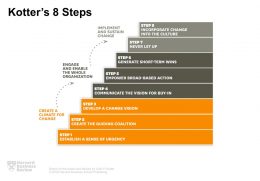 ‘Kotter’s 8 Step Process for Leading Change’ was introduced last week as a helpful model for understanding and managing change, particularly when used in conjunction with a Strategic Planning Process and associated Strategic Plan. It’s important to reiterate that while Kotter’s steps appear linear, there needs to be concurrent/parallel activity which is overlaid and aligned with the Strategic Plan.
‘Kotter’s 8 Step Process for Leading Change’ was introduced last week as a helpful model for understanding and managing change, particularly when used in conjunction with a Strategic Planning Process and associated Strategic Plan. It’s important to reiterate that while Kotter’s steps appear linear, there needs to be concurrent/parallel activity which is overlaid and aligned with the Strategic Plan.
Kotter’s model is not, in my opinion, a strategy in itself, but rather a very good overlay to optimise the likelihood of success. The steps are shown in the diagram below:

We will now look at the first step in ‘Creating a Climate for Change’ which Kotter describes as:
Step 1 – ‘Establish a Sense of Urgency’
Change is difficult, transformation is very difficult. Without a genuine sense of urgency, minor change will falter and transformation will not progress from anything more than an idea. The Great Commission has a strong sense of urgency, yet for many of us, that urgency gets lost in a sea of activities and ‘being busy’, leaving little time for even considering a sense of urgency, let alone doing anything about it. Of course, urgency does exist, but what are we urgent about?
Leaders rarely tell you they have sufficient spare capacity to create and deliver strategic change and direction for their organisations, yet if they’re not doing this, it raises a serious question about whether they are actually leading. Maybe they are just delivering a 24/7 set of management activities on a rudderless ship.
Leadership capacity and expectation
Returning to the notion of organisational drift being what’s currently predictable without leadership intervention, then a key role of leadership is to intervene in that drift, create a sense of urgency, and make something happen that wasn’t going to happen already. Until leaders are equipped to increase their leadership capacity, rather than the amount of hours they work, they will return time after time to stories of how difficult it is, the peculiarity/uniqueness of their circumstances and a host of reasons why they can’t actually lead. Perhaps there is indeed ‘nothing new under the sun’.
If the senior leader and senior leadership team themselves have no true sense of urgency, then we shouldn’t expect others to be excited, enrolled, inspired or motivated. Don’t export something you don’t believe in yourself. Evidence of urgency will ultimately be seen through people behaving differently and relentlessly purging the non-essential to make capacity for the most important activities.
Next week we will look at the next 2 steps in ‘Creating a Climate for Change’.
